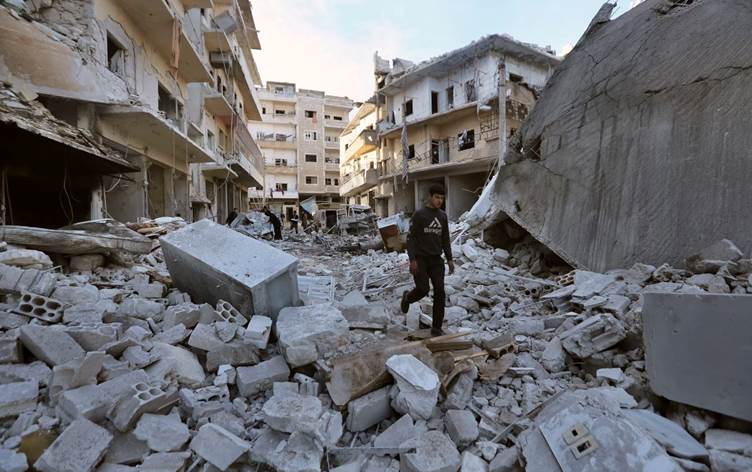Syria


A man walks past destruction resulting from airstrikes on the town of Ariha, in Idlib province, Syria on January 30, 2020. Photo: Ghaith Alsayed/AP
prev
next
ERBIL, Kurdistan Region - Syria has witnessed the largest escalation in fighting in the last four years since October, a United Nations commission warned in a report on Monday, stressing that the country is in desperate need of a ceasefire.
“Since October, Syria has seen the largest escalation in fighting in four years. With the region in turmoil, a determined international effort to contain the fighting on Syrian soil is imperative,” said Paulo Pinheiro, the Chair of the UN Syria Commission of Inquiry.
The report found that the escalation in fighting in Syria began on October 5 when explosions rocked a graduation ceremony at a military academy in Homs, killing at least 63 people, including 37 people. In retaliation, Syrian regime and Russian forces carried out strikes targeting over 2,300 locations in rebel-held parts of the country.
In northeast Syria (Rojava), the commission said that the Turkish military had “accelerated operations” against the Kurdish-led Syrian Democratic Forces (SDF), noting that the attacks had deprived almost one million people of electricity and water, in violation of international humanitarian law, and pointing out that indiscriminate attacks on civilian areas could amount to war crimes.
“Civilians were also killed in targeted aerial attacks fitting a pattern of Turkish drone strikes. Such attacks may amount to war crimes,” the report added.
Violence in Rojava was also compounded by the infighting between the SDF and a coalition of tribes in Deir ez-Zor.
“Syria, too, desperately needs a ceasefire,” Pinheiro added.
“Syrian Government forces again used cluster munitions in densely populated areas, continuing devastating and unlawful patterns that we have documented in the past,” said Commissioner Hanny Megally.
Syrians rose up against the regime of President Bashar al-Assad in March 2011, leading to a full-scale civil war that has claimed the lives of hundreds of thousands of people and has left millions more in need of dire humanitarian assistance.
A new wave of violence swept the country when the Islamic State (ISIS) rose to power and took control of parts of the country, opening a new front to the war that saw the entrance of a US-led coalition. While ISIS has been defeated territorially, sporadic attacks still occur.
Numerous fronts exist in the conflict in Syria, involving multiple state and non-state actors. The Syrian regime, backed by Russian air power, continues to carry out strikes on rebel-held areas, particularly in Idlib.
Half of Idlib province, as well as parts of Aleppo, Hama, and Latakia provinces, are the last rebel-held bastions in the country. Hay’at Tahrir al-Sham (HTS), the former Syrian branch of al-Qaeda, is the prominent force among dozens of different rebel factions operating in the rebel-held northwest. It controls large swathes of Idlib and parts of Aleppo, Hama, and Latakia provinces.
“More than 90% now live in poverty, the economy is in freefall amid tightening sanctions, and increased lawlessness is fuelling predatory practices and extortion by armed forces and militia,” Pinheiro warned.
The report added that since the war in Gaza broke out on October 7, tension within Syria has increased, further raising concerns of an escalation into a wider conflict involving Iran, Israel, and the US. Israel reportedly struck Iran-affiliated forces and sites in Syria at least 35 times, as well as Aleppo and Damascus airports, causing a temporary disruption in vital UN humanitarian air assistance.
Pro-Iranian militia groups in Syria attacked US bases in Syria over 100 times, the report added, with the US responding by carrying out strikes on militias.
“Since October, Syria has seen the largest escalation in fighting in four years. With the region in turmoil, a determined international effort to contain the fighting on Syrian soil is imperative,” said Paulo Pinheiro, the Chair of the UN Syria Commission of Inquiry.
The report found that the escalation in fighting in Syria began on October 5 when explosions rocked a graduation ceremony at a military academy in Homs, killing at least 63 people, including 37 people. In retaliation, Syrian regime and Russian forces carried out strikes targeting over 2,300 locations in rebel-held parts of the country.
In northeast Syria (Rojava), the commission said that the Turkish military had “accelerated operations” against the Kurdish-led Syrian Democratic Forces (SDF), noting that the attacks had deprived almost one million people of electricity and water, in violation of international humanitarian law, and pointing out that indiscriminate attacks on civilian areas could amount to war crimes.
“Civilians were also killed in targeted aerial attacks fitting a pattern of Turkish drone strikes. Such attacks may amount to war crimes,” the report added.
Violence in Rojava was also compounded by the infighting between the SDF and a coalition of tribes in Deir ez-Zor.
“Syria, too, desperately needs a ceasefire,” Pinheiro added.
“Syrian Government forces again used cluster munitions in densely populated areas, continuing devastating and unlawful patterns that we have documented in the past,” said Commissioner Hanny Megally.
Syrians rose up against the regime of President Bashar al-Assad in March 2011, leading to a full-scale civil war that has claimed the lives of hundreds of thousands of people and has left millions more in need of dire humanitarian assistance.
A new wave of violence swept the country when the Islamic State (ISIS) rose to power and took control of parts of the country, opening a new front to the war that saw the entrance of a US-led coalition. While ISIS has been defeated territorially, sporadic attacks still occur.
Numerous fronts exist in the conflict in Syria, involving multiple state and non-state actors. The Syrian regime, backed by Russian air power, continues to carry out strikes on rebel-held areas, particularly in Idlib.
Half of Idlib province, as well as parts of Aleppo, Hama, and Latakia provinces, are the last rebel-held bastions in the country. Hay’at Tahrir al-Sham (HTS), the former Syrian branch of al-Qaeda, is the prominent force among dozens of different rebel factions operating in the rebel-held northwest. It controls large swathes of Idlib and parts of Aleppo, Hama, and Latakia provinces.
“More than 90% now live in poverty, the economy is in freefall amid tightening sanctions, and increased lawlessness is fuelling predatory practices and extortion by armed forces and militia,” Pinheiro warned.
The report added that since the war in Gaza broke out on October 7, tension within Syria has increased, further raising concerns of an escalation into a wider conflict involving Iran, Israel, and the US. Israel reportedly struck Iran-affiliated forces and sites in Syria at least 35 times, as well as Aleppo and Damascus airports, causing a temporary disruption in vital UN humanitarian air assistance.
Pro-Iranian militia groups in Syria attacked US bases in Syria over 100 times, the report added, with the US responding by carrying out strikes on militias.







Comments
Rudaw moderates all comments submitted on our website. We welcome comments which are relevant to the article and encourage further discussion about the issues that matter to you. We also welcome constructive criticism about Rudaw.
To be approved for publication, however, your comments must meet our community guidelines.
We will not tolerate the following: profanity, threats, personal attacks, vulgarity, abuse (such as sexism, racism, homophobia or xenophobia), or commercial or personal promotion.
Comments that do not meet our guidelines will be rejected. Comments are not edited – they are either approved or rejected.
Post a comment